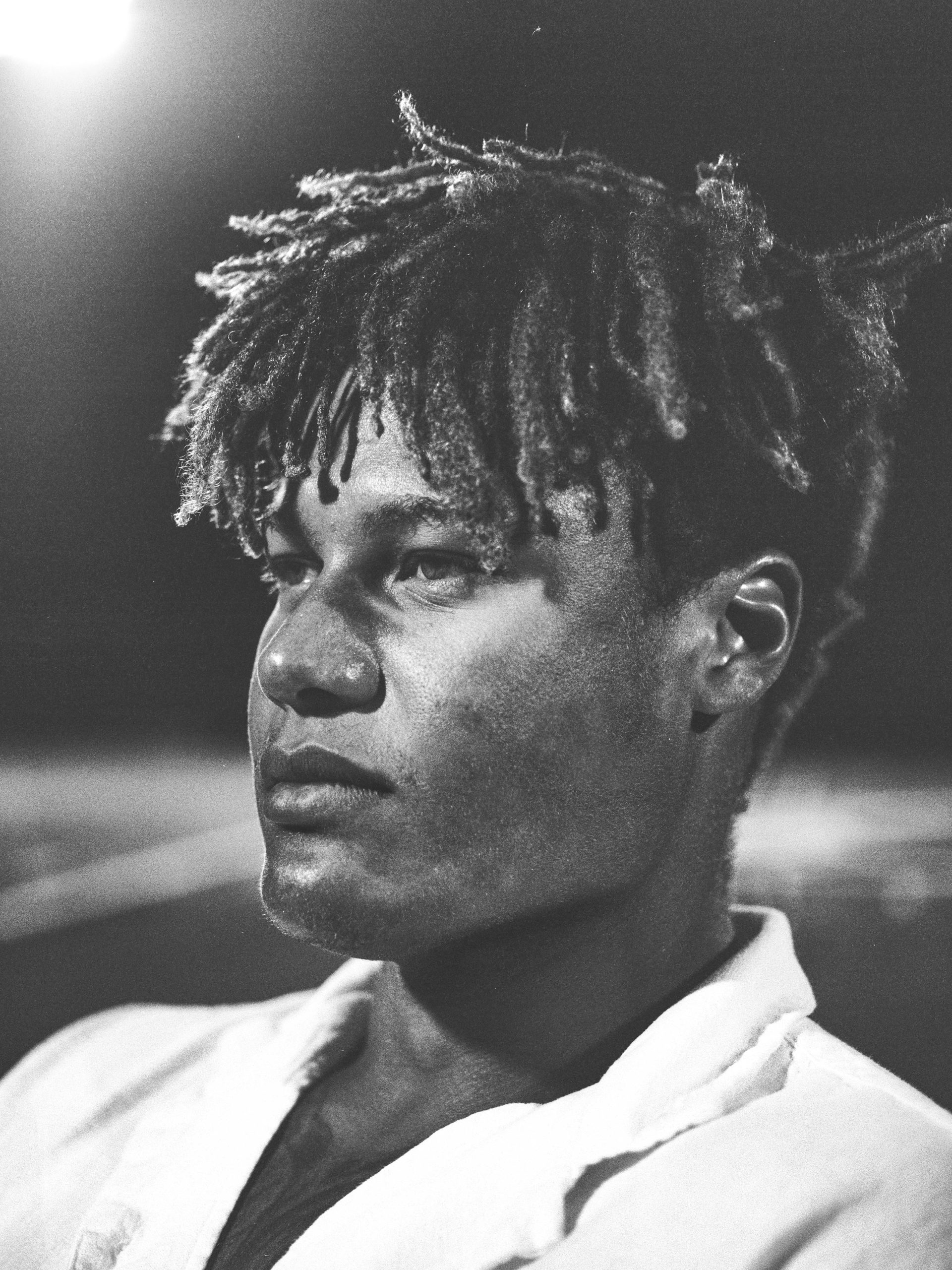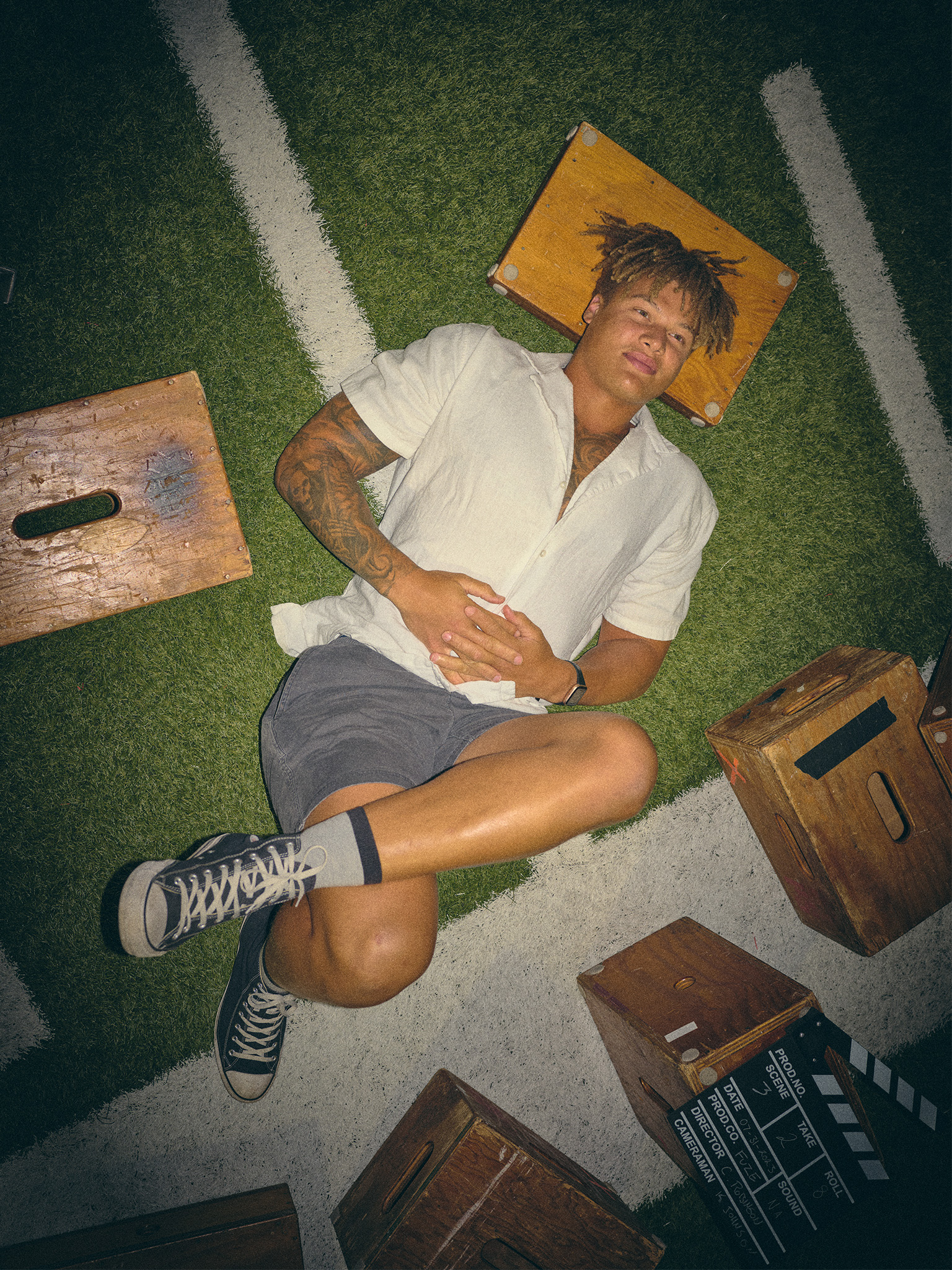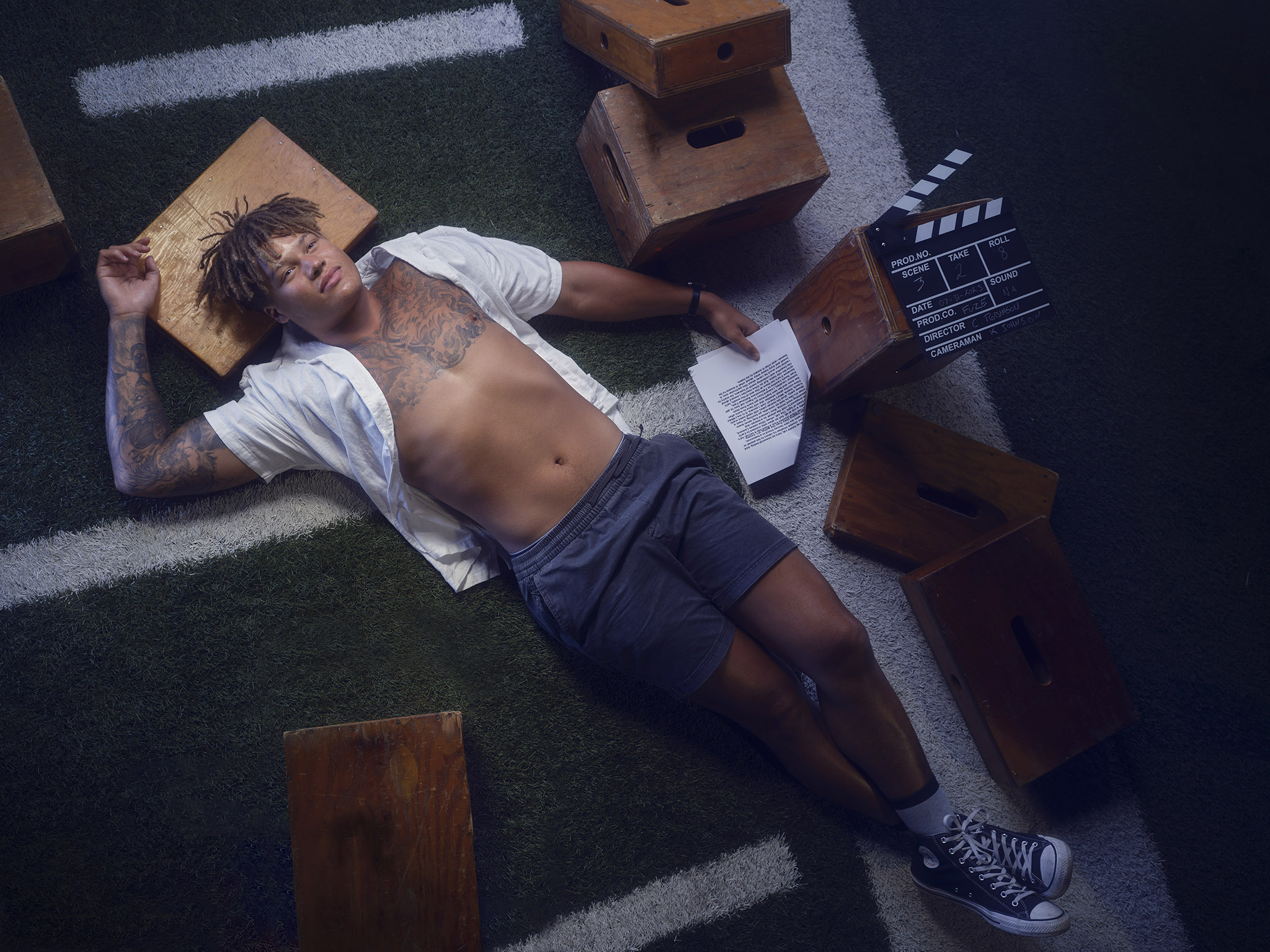Creativity Afield
by Michael Grange
photography by Chris Robinson and Horst Herget
From a distance, the two worlds couldn’t seem more different, the cliché’s splintering off in opposite directions, the stereotypes clashing. But truths in life often defy easy categorization or simple definition. Two things – even seemingly different things like sports and the arts – can be one, you just have to know how to look, where to find the common ground.
THEN AGAIN, FOR KAYDEN JOHNSON, it’s simple. He easily and enthusiastically straddled both worlds while starring on the football field and on the track for York University, while simultaneously finding engagement, enrichment and fulfilment as a theatre major in the School of the Arts, Media, Performance & Design (AMPD).
The 2020 graduate is more commonly recognized for his exploits on the football field as a record-setting, fleet-footed, bruising running back for the Lions, or for exploding from the starting blocks – all power, grace and fury – as a hurdler on the track team. Athletically, his impact was measurable and lasting.
Even after missing all but one game of his last season of football due to an injury, he finished 10th all-time in rushing yards and seventh in rushing touchdowns. He was chosen by the BC Lions in the 2020 CFL draft. In 2017-18, Johnson won gold medals at the OUA and USports championships in the 60-metre hurdles, was named all-Canadian and York’s athlete of the year.
The confidence that you have to have, and perfectionist type of attitude you need to have as an athlete carried over to nailing my lines.
And while he honed his talents through training and repetition, fine-tuning his strength, timing and explosiveness as he maneuvered his six-foot-two, 225-pound frame through and around opposing defenses or barrelling up the track at the crack of a starting pistol, Johnson credits his athletic success in part to the skills and confidence he gained as a theatre major. Now an actor, personal trainer and aspiring winter Olympian in bobsleigh based in Vancouver, when Johnson looks back at his time at York, he’s as proud of the preparation he put into mastering the nuances of the character Belize – the retired drag queen turned nurse from Angels in America – for a reading in class, as he is of his athletic accomplishments.
More than that, he believes one discipline informed the other.






“The confidence that you have to have, and perfectionist type of attitude you need to have as an athlete carried over to nailing my lines,” he said. “But when you’re acting, you always have to be vulnerable when you’re playing these characters, and put yourself out there, so that helped in turn in sports. It helped being authentic and more confident and brave stepping out on the field or the track.”
During his time at York, Johnson was the only varsity athlete in the theatre program. It was a subject of curiosity in both camps. But existing between them, Johnson saw more in common with what it took for him to take on the role of Belize in class or thrive as a running back on Saturday afternoons for the Lions. But if you look for them, the parallels begin to jump out: sports and the arts are both avenues for personal expression, meant to be shared with an engaged audience, but only after years spent refining skills, typically while working in groups.
I think the people who are successful in [either] area, regardless of how you define success, are the people who really feel compelled to embrace and commit to this daily practice.
The ultimate is when the audience rounds out the environment, providing the final jolt of energy, awe and passion.
It’s peak human.
Few understand the parallels better than Sarah Bay-Cheng, dean of AMPD. Almost since she can remember, the northern California native has had a foot in both worlds. She grew up with a passion for theatre – passed on to her by her parents – and a deep love of sports that remains part of her cellular composition to this day, as an artist, an arts administrator, and a still very active athlete. “Like athletes, I think that artists of all kinds – painters, sculptors, dancers, musicians – it’s a daily practice,” Bay-Cheng says. “And I think the people who are successful in [either] area, regardless of how you define success, are the people who really feel compelled to embrace and commit to this daily practice.”
The arts are a team sport.
Her career in the arts has in some ways been shaped by sports. She decided not to play Division 1 basketball at university because the demands would mean giving up theatre, so she enrolled at Wellesley College in Massachusetts, where she was the point guard and captain of the basketball team at the Division III level, and was simultaneously able to throw herself into her theatre degree. She did her master’s at Purdue, choosing to study there in part because it’s a basketball school in Indiana, the sport’s heartland. Even as her career in the arts flourished, she was always engaged in sports, trading basketball for rugby in her graduate years, and team sports for more individual pursuits like running and triathlon after that. She’s been a regular participant in a pick-up basketball game organized by cinema and media arts professor Michael Zryd that features a number of colleagues and alumni with a shared passion for hoops and the arts. Decades into her career, and now leading an institution where dancers, actors, designers and filmmakers are working to master their talents, her college role as point guard – the player on the floor who organizes, leads and shares – remains her internal compass.
“The arts are a team sport,” Bay-Cheng says. “The things that I do now as dean, I go back to what I learned as a theatre director and what I learned as a point guard. It’s the same kinds of team building, group dynamics, common goal motivation.”


Sometimes the lines between sports and the arts are so blurred as to barely exist at all. Within AMPD, Bay-Cheng can refer to multiple examples. Patrick Alcedo, the chair of the department of dance at AMPD, is making a film about the intersection of dance, sports and athletics. Danielle A.D. Howard, a professor in AMPD, is working on a manuscript entitled Making Moves: Race, Basketball, and Embodied Resistance that spans the 20th and 21st centuries. The project examines Black basketball players’ virtuosic and improvisational movements as oriented toward a kinetic knowledge of freedom and akin to contemporaneous jazz aesthetics.
For Amar Wala (BFA ’08), another participant in the AMPD pick-up runs, his own background in basketball is typically a source of strength during the grinding days of filmmaking.
“The parallels exist internally for me, because I grew up playing a lot of sports and basketball was my main sport, and I was good at it by 1990s/2000s Scarborough high school standards,” he says. “But I still play and it’s a huge part of my health, my mental well-being, and my ability to stay fit for my own work, which is extremely physical, whether it’s documentary making or the four weeks I’m about to shoot a feature, it’s going to be wall-to-wall, endurance is a really important thing.”
What I love about basketball and currently love about filmmaking, too, is there is a team aspect to it which is really important.
In the course of his other projects his connection with the sport is even more linear. One of the joys of Wala’s career has been the opportunity to collect behind-the-scenes footage with Canada’s men’s national team, a group laden with NBA talent, as they work toward qualifying for the 2024 Olympics in Paris. On shoots that often have constraints of time and access, Wala says his group is as much a team as what’s happening before his lenses on the hardwood.
“What I love about basketball and currently love about filmmaking, too, is there is a team aspect to it which is really important,” says Wala, who has previously produced and directed a documentary on Raptors “superfan” Nav Bhatia for CBC. “And I think when you work in documentary units which are often four people or five if you’re lucky, it’s very similar. You have to play off one another and communicate really well. There are definitely parallels to being on the court when you actually shoot this stuff, especially when you’re shooting in real time and working with a certain amount of scrutiny when there are NBA athletes around or top-level coaches you have to be very, very serious about what you’re doing and be very careful about where you are on the court and how to capture things that feel real and authentic.”
But in that pursuit, some hard-won sweat equity can pay dividends as well. It can be as simple as explaining to a sound engineer, that yes, the ear-splitting screeches of rubber on wood made when elite athletes change direction at full speed is actually exactly the type of ambient sound a basketball project needs, or finding ways to capture the artistic and aesthetic wonder that giant, extraordinarily gifted athletes playing basketball at a world-class level represent.
“I’m trying to get the feeling of what it’s like when a 240-pound athlete who can jump 40 inches in the air jumps, catches the ball and comes down.”
But the final connection between the arts and sports may be in the feeling those involved get when something clicks or comes together – at least to the outside world, blind to the hours, pains and doubts required to make things work – seemingly seamlessly. Great art, like perfect moments in sport, elevate everyone they touch. They never come easily or instantly, but the feeling is one for sharing. Like a great play or perfect shot, or flawlessly delivered dramatic scene, it provides its own reward and justification for everything required to make it so.
“You do have those moments when you are in the zone, you’re not thinking about anything else, you’re not thinking about any of the other stuff going on in your life,” Wala says. “And at the end of the day, you know you did something cool, or got something special, and it kind of makes you feel really good, and there’s this euphoria afterwards.”
Any athlete or artist – or combination thereof – can understand. ■